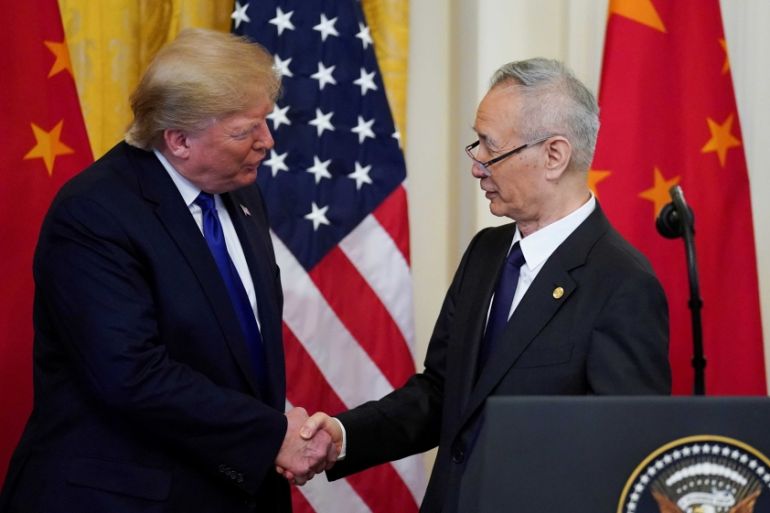The oil and coronavirus crises may hasten US geopolitical decline
The economic and oil crises could usher in a period of higher tensions between the US and China.

The continuing COVID-19 crisis has complicated geopolitics in many different ways. The geopolitics of oil is one prominent example.
The economic misery enveloping the world, deepened by the crash in oil prices, has sharpened a split within the United States ruling elite. Those who support and fund President Donald Trump are aligned with domestic US energy companies that suddenly face a great risk from plummeting oil and gas demand. This abrupt market downturn has forced Whiting Petroleum to file for bankruptcy and there are already reports that Chesapeake Energy is preparing to do the same. Many others may follow.
Keep reading
list of 4 itemsWhat’s slowing down America’s clean energy transition? It’s not the cost
Global coal use to reach record high in 2023, energy agency says
COP28 Dubai is over: Four key highlights from the UN climate summit
Many of these companies produce oil by the costly “fracking” of shale deposits and were already heavily in debt prior to the COVID-19 crisis.
From 2006 to 2014, 16 publicly traded shale oil companies had exceeded the debit side of their balance sheet over the credit side by more than $80bn. At current, depressed prices, most of them are likely to face bankruptcy before long. As Quartz has reported, “not one of the 100 largest fracking operations in the country can turn a profit”.
It is not surprising that the owners of these companies are mobilising Trump’s racist “Make America Great Again” (MAGA) base in a desperate attempt to save themselves. The American Legislative Exchange Council (backed by key Trump supporters, the Koch family) and the Michigan Freedom Fund (linked to the Trump supporters, the DeVos family) have backed gun-toting protests at state capitols.
They are demanding an immediate reopening of local economies, even as thousands of people are being exposed to the risk of infection and the death toll from COVID-19 increases every day crossing the tragic 100,000 mark as the nationwide total.
While the heavily armed white demonstrators with swastikas, nooses, and Confederate flags are repulsive, the other “liberal” side in this fight is also not reassuring to the American citizen.
The neoliberal mainstream Democrats, who trace their origin to the descendants of John D Rockefeller and his Standard Oil monopoly, are spearheaded by multinational oil and finance capital companies. To protect their long-term profits, they are pushing for a slower emergence from the pandemic lockdown.
Their position is supported by the best medical science and that has led to even more panic and fact denial by Trump and his supporters. Where is this internal fight headed?
Since deep-pocketed giants like ExxonMobil are better equipped to wait out a price squeeze than smaller domestic companies, they can wait while they watch their domestic competition wither and die.
In fact, from the neoclassical realist perspective in international relations, it is not an unreasonable bet that the neoliberal politicians – many of whom, like former Democratic presidential candidate Hillary Clinton, were already largely aligned with the neocons in foreign policy – are planning for even wider-scale confrontations with their perceived global rivals China and possibly Russia.
Thus, the oil crash further complicates already unstable geopolitics. Clearly, the historic, pandemic-driven reduction in energy demand lies at the root of the current oil price crisis. But the virus is not solely to blame.
In early March, when the global economy was still running at a “normal” pace, Saudi Arabia and Russia launched a price war that flooded the market with millions of additional barrels of oil. Republican Senator Ted Cruz suggested Saudi Arabia, the once-reliable US partner, was intentionally driving US shale oil producers out of business.
Undoubtedly, the US leadership’s loss of influence in the Middle East, even with so-called allies like Saudi Arabia and Israel, has been accelerated by the isolationist and incompetent Trump administration.
However, more worrisome is the prospect that this decline may be a sign of further geopolitical instabilities to come. As China and Russia seek to fill the void from the US geopolitical decline, the Middle East region is becoming even more unstable than usual. The two main perceived – that is to say, perceived by the US foreign policy establishment – challengers to US dominance could emerge from this crisis stronger than before.
US sanctions against Russian oil forced Russia to diversify its economy, leaving it “in very good shape to cope with lower [oil] prices“. China, a net importer of oil, clearly gains economically from lower oil and gas prices. Furthermore, the people’s republic has evolved – at least partly – into a form of state capitalism. Therefore, the Chinese government actively supports its national oil companies which are considered to be of strategic importance.
Combined with the healthcare and economic disasters of the pandemic, the latest conflict over oil could accelerate the US’s economic and geopolitical decline leading to unpredictable behaviour by the US leadership.
With respect to China, some confusing, aggressive behaviour of the US military is already on display. In April, the US sent the guided-missile destroyer USS Barry to sail near the Paracel Islands, a disputed archipelago in the contested South China Sea. Shortly after, the US flew two Air Force B-1B bombers over the South China Sea in a provocative show of force.
I am not predicting larger confrontations in the immediate future. Whether hotspots anywhere including, the strait of Hormuz, a hotspot of tensions between Iran and its Arab neighbours, will lead to regional wars is far from certain. But with growing US-China friction, changing alliances and new geopolitical alignments, the risk of violent regional confrontations will most likely increase.
The views expressed in this article are the author’s own and do not necessarily reflect Al Jazeera’s editorial stance.
